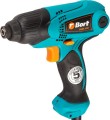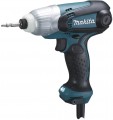Power consumption
The total power consumed by a mains-powered electric tool (see "Power Source"). It is considered the main criterion for assessing the overall capabilities of a particular model: more power allows you to achieve more speed and/or torque. However a more correct parameter for such an assessment is useful (working) power, but it is far from always indicated, and tools of the same type with similar power consumption usually do not differ much in terms of working power. In addition, data on power consumption also allows you to estimate the load on the power grid or other power source; in some cases this is unnecessary.
As for specific figures, for different types of tools, the characteristic power values will be different. For example,
from 750 to 1000 W is considered a very solid indicator for a screwdriver, while for classic drills this is an average value, among such devices there are options even for
1.5 kW or more. Detailed recommendations on choosing a tool for this parameter can be found in special sources. We only note that it does not always make sense to chase the maximum values high power noticeably affects the dimensions, weight and price of the unit, despite the fact that it is far from always required.
Max. beats
The number of beats per minute provided by a tool that supports the corresponding mode.
For more information about this mode, see "Functions", here we note that it can be provided both in drills and in screwdrivers and wrenches (see "Device"), and the meaning of the impact mode in these varieties is somewhat different. Therefore, the speeds differ: many drills are capable of delivering about 48,000 beats / min, or even 64,000 beats / min, while in screwdrivers and wrenches, 3200 beats / min are considered “classics of the genre”, and values above 3500 beats / min are practically do not meet.
The general meaning of this indicator is also directly related to the type. So, among drills, the difference in chiseling speed can be quite large. With these tools, more strokes improve overall productivity and efficiency, while fewer strokes improve accuracy and reduce the risk of damaging delicate materials. In screwdrivers and nutrunners, high speed also contributes to overall efficiency, but for most of these tools, the differences in this indicator are not significant enough to be noticeable in practice.
Cable length
The length of the cord attached to the mains powered tool (see "Power Source").
The longer the wire - the farther from the outlet you can use the tool without switching it, the more freedom the user has. On the other hand, an overly long cable creates inconvenience during storage and transportation, and even during operation it can get under your feet (or even your hands). Given this, in most cases, manufacturers equip their products with network cables from 2 to 4 m long. This gives a sufficient degree of freedom without creating inconvenience, and for situations where the length of the wire is not enough, there are extension cords. Of course, even in this range, you can choose a cable for a specific situation: for example, for a city apartment 2 - 2.5 m will be quite enough, but for a construction site it is desirable to have a longer wire.
Weight
The total weight of the tool is usually the device itself, without attachments. For battery models (see "Power Source"), usually, the weight is indicated with a standard battery installed; for battery-powered models, the weight can be given both with and without batteries, but in this case this point is not particularly important.
Other things being equal, less weight simplifies work, increases accuracy of movement and allows you to use the tool for longer without tiring. However, note that high power and productivity inevitably increase the mass of the tool; and various tricks to reduce weight increase the price and can reduce reliability. In addition, in some cases, a massive design is more preferable. First of all, this applies to work with a large load — for example, drilling holes of large diameter, or making recesses with impact: a heavy tool is more stable, it is less prone to jerks and shifts due to uneven material, vibration of mechanisms, etc.
It is also worth noting that specific weight values are directly related to the type of tool (see "Device"). Screwdrivers are the lightest — in most of them this figure
does not exceed 500 g. Screwdrivers and drill drivers are more "heavy": their average weight is
1.1 – 1.5 kg, although there are many lighter (
0.6 – 1 kg) and heavier (
1.6 – 2 kg or more ) models. And clas
...sic drills and wrenches have the greatest weight: such a tool must be quite powerful, so for them 1.6 – 2 kg is an average, 2.1 – 2.5 kg is above average, and many units weigh more than 2, 5 kg.
